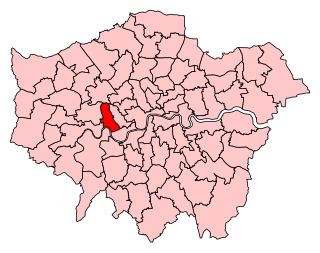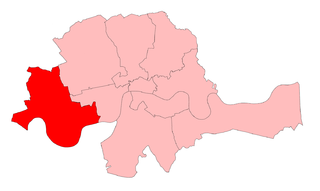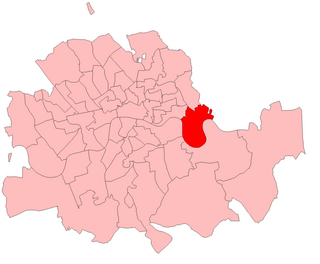History

The constituency was created by the Redistribution of Seats Act 1885 for the 1885 general election, and abolished for the 1918 general election.
| Hoxton | |
|---|---|
| Former Borough constituency for the House of Commons | |
| 1885–1918 | |
| Number of members | one |
| Replaced by | Shoreditch |
| Created from | Hackney |
Hoxton was a borough constituency centred on the Hoxton district of London. It returned one Member of Parliament (MP) to the House of Commons of the Parliament of the United Kingdom, elected by the first past the post system.

The constituency was created by the Redistribution of Seats Act 1885 for the 1885 general election, and abolished for the 1918 general election.

The constituency was created in 1885, as a division of the parliamentary borough of Shoreditch in the East End of London. The area was administered as part of the Tower division of the county of Middlesex.
The division consisted of the Church, Hoxton, Moorfields and Wenlock wards.
In 1889 there were administrative changes. The territory of the constituency was severed from Middlesex and included in the new County of London. The lower tier of local government in the area continued to be administered by parish vestries and local boards of works.
In 1900 local government in London was rationalised. The civil parish of St. Leonard, Shoreditch became part of a larger Metropolitan Borough of Shoreditch.
In the redistribution of parliamentary seats in 1918, the Metropolitan Borough of Shoreditch constituted a single parliamentary division of Shoreditch. The Hoxton division was abolished.
| Election | Member | Party | |
|---|---|---|---|
| 1885 | James Stuart | Liberal | |
| 1900 | Claude Hay | Conservative | |
| 1910 | Christopher Addison | Liberal | |
| 1918 | constituency abolished | ||
| Party | Candidate | Votes | % | ±% | |
|---|---|---|---|---|---|
| Liberal | James Stuart | 3,084 | 60.1 | ||
| Conservative | Robert Arthur Germaine | 2,047 | 39.9 | ||
| Majority | 1,037 | 20.2 | |||
| Turnout | 5,131 | 60.6 | |||
| Registered electors | 8,469 | ||||
| Liberal win (new seat) | |||||
| Party | Candidate | Votes | % | ±% | |
|---|---|---|---|---|---|
| Liberal | James Stuart | 2,324 | 52.8 | −7.3 | |
| Conservative | Robert Arthur Germaine | 2,079 | 47.2 | +7.3 | |
| Majority | 245 | 5.6 | −14.6 | ||
| Turnout | 4,403 | 52.0 | −8.6 | ||
| Registered electors | 8,469 | ||||
| Liberal hold | Swing | -7.3 | |||
| Party | Candidate | Votes | % | ±% | |
|---|---|---|---|---|---|
| Liberal | James Stuart | 3,410 | 61.6 | +8.8 | |
| Conservative | Claude Hay | 2,114 | 38.1 | −9.1 | |
| Labour Union | Alexander Karley Donald | 19 | 0.3 | New | |
| Majority | 1,296 | 23.5 | +17.9 | ||
| Turnout | 5,543 | 69.2 | +17.2 | ||
| Registered electors | 8,011 | ||||
| Liberal hold | Swing | +9.0 | |||

| Party | Candidate | Votes | % | ±% | |
|---|---|---|---|---|---|
| Liberal | James Stuart | 2,990 | 51.1 | −10.5 | |
| Conservative | Claude Hay | 2,862 | 48.9 | +10.8 | |
| Majority | 128 | 2.2 | −21.3 | ||
| Turnout | 5,852 | 66.6 | −2.6 | ||
| Registered electors | 8,789 | ||||
| Liberal hold | Swing | −10.7 | |||
| Party | Candidate | Votes | % | ±% | |
|---|---|---|---|---|---|
| Conservative | Claude Hay | 2,866 | 52.5 | +3.6 | |
| Liberal | James Stuart | 2,595 | 47.5 | −3.6 | |
| Majority | 271 | 5.0 | N/A | ||
| Turnout | 5,461 | 70.1 | +3.5 | ||
| Registered electors | 7,789 | ||||
| Conservative gain from Liberal | Swing | +3.6 | |||

| Party | Candidate | Votes | % | ±% | |
|---|---|---|---|---|---|
| Conservative | Claude Hay | 3,489 | 55.9 | +3.4 | |
| Liberal | Henry Ward | 2,753 | 44.1 | −3.4 | |
| Majority | 736 | 11.8 | +6.8 | ||
| Turnout | 6,242 | 80.5 | +10.4 | ||
| Registered electors | 7,754 | ||||
| Conservative hold | Swing | +3.4 | |||

| Party | Candidate | Votes | % | ±% | |
|---|---|---|---|---|---|
| Liberal | Christopher Addison | 3,736 | 52.4 | +8.3 | |
| Conservative | Claude Hay | 3,398 | 47.6 | −8.3 | |
| Majority | 338 | 4.8 | N/A | ||
| Turnout | 7,134 | 83.6 | +3.1 | ||
| Registered electors | 8,530 | ||||
| Liberal gain from Conservative | Swing | +8.3 | |||
| Party | Candidate | Votes | % | ±% | |
|---|---|---|---|---|---|
| Liberal | Christopher Addison | 3,489 | 55.5 | +3.1 | |
| Conservative | Francis Francis | 2,795 | 44.5 | −3.1 | |
| Majority | 694 | 11.0 | +6.2 | ||
| Turnout | 6,284 | 73.7 | −9.9 | ||
| Registered electors | 8,530 | ||||
| Liberal hold | Swing | +3.1 | |||

Hammersmith is a parliamentary constituency in the House of Commons of the UK Parliament. It is currently represented by Andy Slaughter, a member of the Labour Party, who has represented the seat since its recreation in 2010.

Chelsea was a borough constituency, represented in the House of Commons of the Parliament of the United Kingdom.
The parliamentary borough of Finsbury was a constituency of the House of Commons of the UK Parliament from 1832 to 1885, and from 1918 to 1950. The constituency was first created in 1832 as one of seven two-seat "metropolis" parliamentary boroughs other than the two which already existed: Westminster and the City of London; the latter until 1885 retained an exceptional four seats. Finsbury was directly north of the City of London and was smaller than the Finsbury division of the Ossulstone hundred but took in land of Holborn division to its southwest in pre-introduction changes by Boundary Commissioners. It included Finsbury, Holborn, Moorfields, Clerkenwell, Islington, Stoke Newington and historic St Pancras. The 1918 constituency corresponded to the smaller Metropolitan Borough of Finsbury ; it was a seat, thus electing a single member, fulfilling a longstanding aim of Chartism which underscored the 1832 reforms.

Hackney North was a parliamentary constituency in "The Metropolis". It returned one Member of Parliament (MP) to the House of Commons of the Parliament of the United Kingdom.
Hackney was a two-seat constituency in the House of Commons of the UK Parliament created under the Representation of the People Act, 1867 from the former northern parishes of the Tower Hamlets constituency and abolished under the Redistribution of Seats Act, 1885.

Clapham was a borough constituency in South London which returned one Member of Parliament (MP) to the House of Commons of the UK Parliament. It was created in time for the 1885 general election then altered in periodic national boundary reviews, principally in 1918, and abolished before the February 1974 general election. In its early years the seat was officially named Battersea and Clapham Parliamentary Borough: No. 2—The Clapham Division.
Stepney was a parliamentary constituency centred on the Stepney district of the East End of London. It returned one Member of Parliament (MP) to the House of Commons of the Parliament of the United Kingdom, elected by the first past the post system.

Whitechapel was a parliamentary constituency in the Whitechapel district of East London. In 1885 the seat was established as a division of the parliamentary borough of Tower Hamlets. It returned one Member of Parliament (MP) to the House of Commons of the Parliament of the United Kingdom.

Hampstead was a borough constituency, centered on the Hampstead area of North London. It returned one Member of Parliament (MP) to the House of Commons of the Parliament of the United Kingdom, who was elected using the first-past-the-post voting system.

Brentford was a constituency named after the town of Brentford in Middlesex and was drawn to take in Hounslow, Norwood Green and Twickenham. It returned one Member of Parliament (MP) to the House of Commons of the UK Parliament. The constituency was created for the 1885 general election and abolished for that of 1918.

Mile End was a parliamentary constituency centred on the Mile End district of the East End of London. It returned one Member of Parliament (MP) to the House of Commons of the Parliament of the United Kingdom.

Poplar was a parliamentary constituency centred on the Poplar district of the East End of London. It returned one Member of Parliament (MP) to the House of Commons of the Parliament of the United Kingdom.

Brixton was a parliamentary constituency centred on the Brixton district of South London. It returned one Member of Parliament (MP) to the House of Commons of the Parliament of the United Kingdom, elected by the first-past-the-post system.

Limehouse was a borough constituency centred on the Limehouse district of the East End of London. It returned one Member of Parliament (MP) to the House of Commons of the Parliament of the United Kingdom.

Bow and Bromley was a constituency in the Parliament of the United Kingdom. Located in the Metropolitan Borough of Poplar in London, it was created by the Redistribution of Seats Act for the 1885 general election and returned one Member of Parliament (MP) until it was abolished for the 1950 general election.
Finsbury Central was a parliamentary constituency that covered the Clerkenwell district of Central London. It returned one Member of Parliament (MP) to the House of Commons of the Parliament of the United Kingdom, elected by the first past the post system.
Finsbury East was a parliamentary constituency centred on the Finsbury district of North London, England. It returned one Member of Parliament (MP) to the House of Commons of the Parliament of the United Kingdom, elected by the first past the post system.
Wandsworth was the name of a borough constituency created in 1885, abolished in 1918, covering the vast bulk of today's London Borough of Wandsworth in South London but excluding Battersea. It returned one Member of Parliament (MP) to the House of Commons of the UK Parliament.
Haggerston, formally known as the "Haggerston Division of Shoreditch", was a borough constituency centred on the Haggerston district of the Metropolitan Borough of Shoreditch in London. It returned one Member of Parliament (MP) to the House of Commons of the Parliament of the United Kingdom, elected by the first past the post system.
St George was a parliamentary constituency in what is now the London Borough of Tower Hamlets. It was part of the Parliamentary borough of Tower Hamlets and returned one Member of Parliament (MP) to the House of Commons of the Parliament of the United Kingdom.